2016 is the 50th anniversary of Star Trek. This puts the onus on Star Trek Beyond to be something more than an entertaining ride, and as it turns out, Beyond gives the franchise a big wet kiss for a birthday present. The film feels very Star Trek-ky, like a story of the original 1960s show on steroids. It’s a dizzying action bonanza, it’s a meaningful tale of ideals being lost and found in space, and it’s surprisingly engaged with what Star Trek means. While still flawed, Beyond has charm to spare, delivering as both a blockbuster and a subtly nerdy filibuster on what the franchise represents.
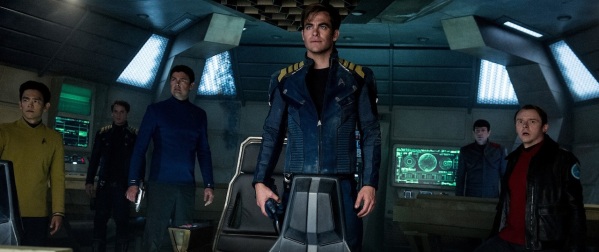
In the 23rd Century, the USS Enterprise is more than halfway through its five-year mission of exploration and diplomacy. Captain James T. Kirk (Chris Pine) feels the ennui of life in deep space, while first officer Spock (Zachary Quinto) receives some disheartening news. A distress signal to the Federation’s advanced starbase Yorktown leads the Enterprise into a deadly trap, engineered by the primal Krall (Idris Elba). With the crew grounded on an alien planet, can Kirk and company save them? And can communications officer Nyota Uhura (Zoe Saldana) unravel the mystery of Krall?
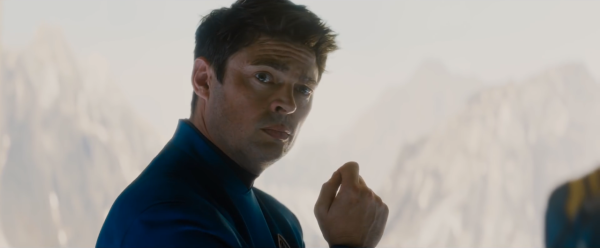
Perhaps the greatest strength of this current sequence of films is the cast, admirably filling the shoes of venerated actors who originated the roles. Beyond pulls off a nice trick, being much more of an ensemble movie than its two predecessors. Whereas before laser focus was on Kirk and Spock, here every main character gets at least a couple moments to shine. Screenwriters Simon Pegg (also starring, as engineer Scotty) and Doug Jung facilitate this by splitting up the cast into pairs and letting the characters play off each other. So a contemplative Kirk mentors young ensign Chekov (Anton Yelchin, tragically no longer with us); Scotty bonds with resourceful alien Jaylah (Sofia Boutella, endearing); Uhura and Sulu (John Cho) learn what the villains are about; and best of all, Spock and sawbones Dr. McCoy (Karl Urban, always the MVP) balance their delightful verbal sparring with a lot of heart.

So checking in with the heroes is a lot of fun. But also, the screenplay is not afraid to pepper wonderfully moral and dorky Star Trek goodness throughout. There’s something really cool about hearing the heroes of a massive action tentpole dole out fortune cookie wisdom about unity, peace, humanism, and the importance of diplomacy. And when these characters have been established as relatable and endearing, this stuff is even more important, because it’s aspirational. By starring relatable characters living in an enlightened time, Star Trek is saying that the future of humanity is brighter, and presents this as a matter of fact.
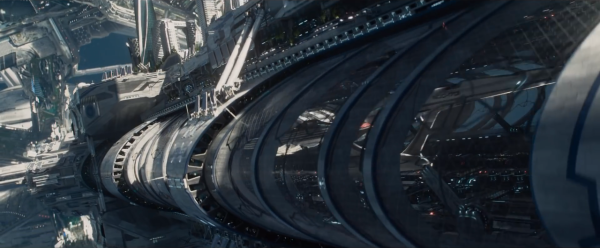
The technology on display factors into this as well. The Yorktown is a great location, an M.C. Escher painting of a starbase, where gravity bends to the architecture. But just by being there and being so impressive, the base symbolizes how far humanity can go when united. Fittingly, the approach to Yorktown is the most spectacular sequence in the film. With jaw-dropping SF visuals and Michael Giacchino’s truly lovely score, it’s really something.
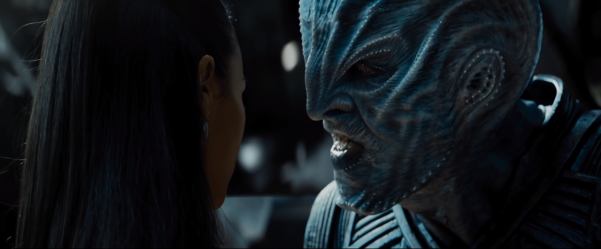
But of course, the Federation’s idealism is challenged by Krall. The problem with Krall is that he’s better in concept than in execution. A foil for the utopian Federation who believes that only struggle and chaos breed progress, he creates a twisted parody of the Federation by bringing down ships from different cultures and feeding on diverse species for his own personal gains. The idea is there, but it’s not more than half-cooked in the movie proper. (Krall’s character does take an essential turn, but I can’t say more about that twist without boldly going into spoilers. See the P.S.) Krall isn’t a total loss of a character; but what we have on screen for most of the runtime is a handicapped Idris Elba, feral and growling, looking for MacGuffin #14 to make generic superweapon #82 to enact stock villainous plan #47.
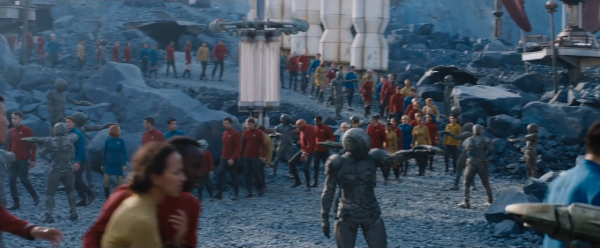
No one said that stopping the stock villainous plan couldn’t look good, though. Director Justin Lin goes above and beyond crafting the action, spinning the camera on its axis and defying gravity with great energy. A particular highlight is the harrowing, if slightly overlong, attack on the Enterprise sequence. (In my first viewing I sometimes lost the geography of these dynamic scenes, but a second go-round rendered them more coherent.) Because Lin had come off directing four Fast and Furious spectacles, his hiring was a subject of a lot of snark and sarcasm. But what’s lost in these discussions is that the true draw of that freewheeling franchise is not the surface stuff, but the teamwork of people who love each other. And that’s very Star Trek.

Beyond exudes a constant love of Star Trek, from an understanding of its tropes to numerous easter eggs for fans. A few favorites: When Kirk fights Krall, the music resembles Fred Steiner’s (in)famous fight music from the original series. The Yorktown was the name of the Enterprise in Gene Roddenberry’s original Star Trek treatment. There are explicit references to the era of the underseen Enterprise TV series. And the approach to Yorktown reminds me of the absurdly long, lingering and loving approach to the Enterprise in Star Trek: The Motion Picture, just more narratively economical.
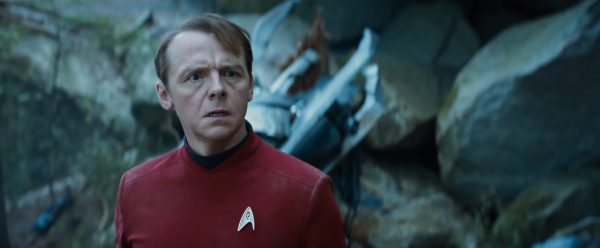
Engineer. Brewer of moonshine. Moonlighter as a writer.
The humor is also on point throughout, which is no surprise considering co-writer Simon Pegg’s previous credits on extraordinary dramedies like Shaun of the Dead, Hot Fuzz, The World’s End, and TV sitcom Spaced. Much of the entertainment value here just comes from seeing the ensemble play off each other, with McCoy and Spock in particular spinning earnestness into comedy gold. The character work and action are on form, supported by a big heart. And even as an element like Krall and his faceless swarm is rough around the edges, the way Beyond gets the Star Trek of it so very right is nothing (for Keenser) to sneeze at. A weak 9/10.
P.S.: *TO EXPLORE STRANGE NEW SPOILERS*
The Balthazar Edison twist is absolutely in keeping with the tropes of the original show, where several starship captains went native and insane. (See “Patterns of Force”, “The Omega Glory”, “Bread and Circuses”, and “Whom Gods Destroy”.) So when Kirk is fighting Edison he’s fighting us, the aggressive and tribalistic human nature that the Federation has risen above. Speaking of that scene and its meta-conflict, “That’s what I was born into” gives me chills and may go on to become an iconic Star Trek quote. I love that this message of idealism is the Trek equivalent of an action movie one-liner.
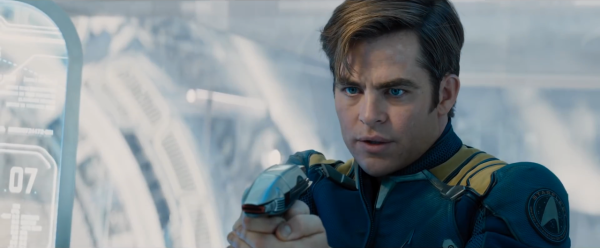
“I’d rather die saving lives than live with ending them. That’s what I was born into.”
Meanwhile, following the death of Leonard Nimoy’s Ambassador Spock, Zachary Quinto’s Spock considers quitting Starfleet and picking up where the elder Spock left off. And the young Spock finds in the Ambassador’s possessions the cast photo from Star Trek 5: The Final Frontier. So it’s the very idea of Star Trek, and the community of that original group of characters, that convinces Spock to continue in Starfleet. Fascinating.

There’s a bit where Scotty says that he didn’t want to beam Spock and McCoy up at the same time, for fear of “splicing” the two. Trek fans know that splicing the two would result in someone resembling one James T. Kirk.
And finally, the twin dedication to Leonard Nimoy and Anton Yelchin is poignant. Especially when Kirk’s “To absent friends” toast cuts right to a shot with Chekov. To the stars they return.
[…] Michael Giacchino’s score is solid, but feels a bit like a missed opportunity. The end credits music (“Master of the Mystic End Credits”) is a fantastic slice of trippy progressive-rock, throwing organs and sitars around with abandon. But by being so distinctive, it gives a tantalizing glimpse at what the whole score could have been – indeed, the main Doctor Strange theme heard throughout the film is oddly similar to Giacchino’s own Star Trek fanfare. […]
LikeLike
[…] 11) Star Trek Beyond […]
LikeLike
[…] Star Trek Beyond > Star Trek Into Darkness […]
LikeLike
[…] cried at the ending. The theme of family is hit so hard. The humanism of this franchise rivals Star Trek. The Fate of the Furious is the first Fast film I love as much as the series itself. […]
LikeLike
[…] magnetic French assassin, Sofia Boutella finds maybe her best role yet (and she has pretty good taste). Best of all is the Nurse, animated by a bravura performance from Foster. She injects world-weary […]
LikeLike